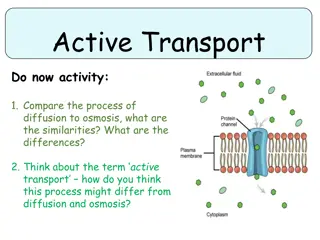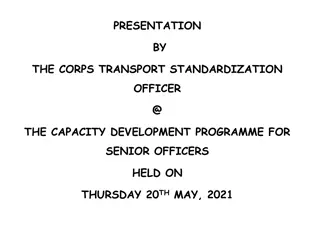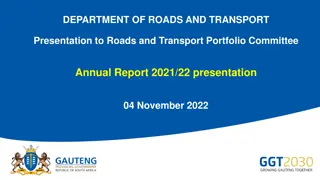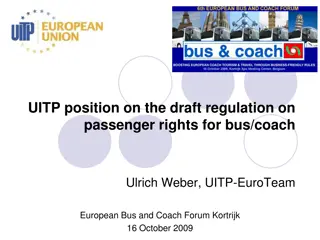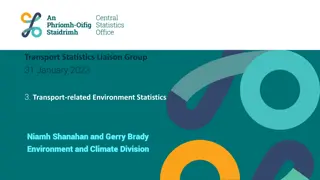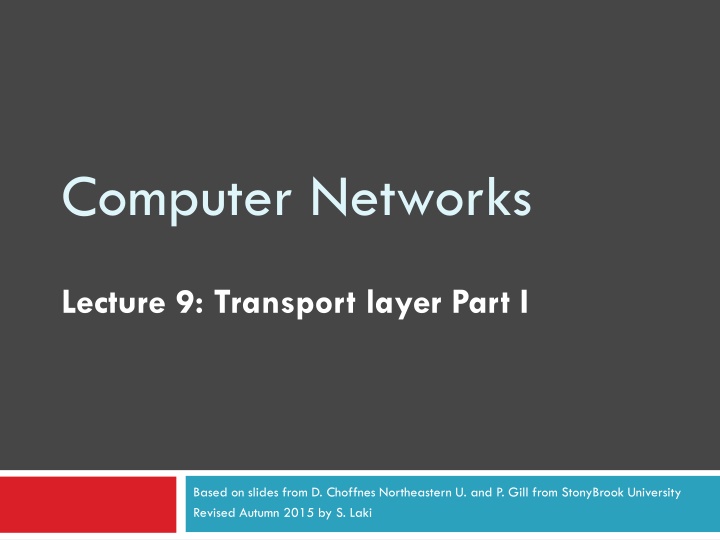
Transport Layer Functions and Multiplexing in Computer Networks
Explore the functions of the transport layer, including demultiplexing, reliable packet delivery, and congestion control. Learn about the importance of multiplexing in a datagram network and how traffic is demultiplexed among different server applications. Delve into the layered communication model and the role of User Datagram Protocol (UDP) in network communications.
Download Presentation

Please find below an Image/Link to download the presentation.
The content on the website is provided AS IS for your information and personal use only. It may not be sold, licensed, or shared on other websites without obtaining consent from the author. If you encounter any issues during the download, it is possible that the publisher has removed the file from their server.
You are allowed to download the files provided on this website for personal or commercial use, subject to the condition that they are used lawfully. All files are the property of their respective owners.
The content on the website is provided AS IS for your information and personal use only. It may not be sold, licensed, or shared on other websites without obtaining consent from the author.
E N D
Presentation Transcript
Computer Networks Lecture 9: Transport layer Part I Based on slides from D. Choffnes Northeastern U. and P. Gill from StonyBrook University Revised Autumn 2015 by S. Laki
Transport Layer 2 Function: Demultiplexing of data streams Application Presentation Session Transport Network Data Link Physical Optional functions: Creating long lived connections Reliable, in-order packet delivery Error detection Flow and congestion control Key challenges: Detecting and responding to congestion Balancing fairness against high utilization
Outline 3 UDP TCP Congestion Control Evolution of TCP Problems with TCP
The Case for Multiplexing 4 Datagram network No circuits No connections Clients run many applications at the same time Who to deliver packets to? Transport Network Data Link Physical IP header protocol field 8 bits = 256 concurrent streams Insert Transport Layer to handle demultiplexing Packet
Demultiplexing Traffic Server applications communicate with multiple clients 5 Host 1 Host 2 Host 3 Unique port for each application Applications share the same network Application Transport P1 P2 P3 P4 P5 P6 P7 Network Endpoints identified by <src_ip, src_port, dest_ip, dest_port>
Layering, Revisited 6 Layers communicate peer- to-peer Host 1 Host 2 Router Application Transport Network Data Link Physical Application Transport Network Data Link Physical Network Data Link Physical Lowest level end-to-end protocol Transport header only read by source and destination Routers view transport header as payload
User Datagram Protocol (UDP) 7 0 16 31 Destination Port Checksum Source Port Payload Length Simple, connectionless datagram C sockets: SOCK_DGRAM Port numbers enable demultiplexing 16 bits = 65535 possible ports Port 0 is invalid Checksum for error detection Detects (some) corrupt packets Does not detect dropped, duplicated, or reordered packets
Uses for UDP 8 Invented after TCP Why? Not all applications can tolerate TCP Custom protocols can be built on top of UDP Reliability? Strict ordering? Flow control? Congestion control? Examples RTMP, real-time media streaming (e.g. voice, video) Facebook datacenter protocol
Outline 9 UDP already discussed TCP Congestion Control Evolution of TCP Problems with TCP
Transmission Control Protocol 10 Reliable, in-order, bi-directional byte streams Port numbers for demultiplexing Virtual circuits (connections) Flow control Congestion control, approximate fairness 0 Source Port Why these features? 4 16 31 Destination Port Sequence Number Acknowledgement Number Flags Checksum HLen Advertised Window Urgent Pointer Options
Connection Setup 11 Why do we need connection setup? To establish state on both hosts Most important state: sequence numbers Count the number of bytes that have been sent Initial value chosen at random Why? Important TCP flags (1 bit each) SYN synchronization, used for connection setup ACK acknowledge received data FIN finish, used to tear down connection
Three Way Handshake 12 Client Server Why Sequence # +1? Each side: Notifies the other of starting sequence number ACKs the other side s starting sequence number
Connection Tear Down 14 Either side can initiate tear down Other side may continue sending data Half open connection shutdown() Acknowledge the last FIN Sequence number + 1 What happens if 2nd FIN is lost? Client Server
Sequence Number Space 15 TCP uses a byte stream abstraction Each byte in each stream is numbered 32-bit value, wraps around Initial, random values selected during setup. Why? Byte stream broken down into segments (packets) Size limited by the Maximum Segment Size (MSS) Set to limit fragmentation Each segment has a sequence number 13450 14950 16050 17550 Segment 8 Segment 9 Segment 10
Bidirectional Communication 16 Client Server Seq. 1 Ack. 23 Seq. 23 Ack. 1 23 1461 1461 753 Data and ACK in the same packet 753 2921 Each side of the connection can send and receive Different sequence numbers for each direction
Flow Control 17 Problem: how many packets should a sender transmit? Too many packets may overwhelm the receiver Size of the receivers buffers may change over time Solution: sliding window Receiver tells the sender how big their buffer is Called the advertised window For window size n, sender may transmit n bytes without receiving an ACK After each ACK, the window slides forward Window may go to zero!
Flow Control: Sender Side 18 Packet Received Packet Sent Src. Port Dest. Port Src. Port Dest. Port Sequence Number Sequence Number Acknowledgement Number Flags Checksum Must be buffered until ACKed Acknowledgement Number Flags Checksum HL Window Urgent Pointer HL Window Urgent Pointer ACKed Sent To Be Sent Outside Window Window
Sliding Window Example 19 TCP is ACK Clocked Short RTT quick ACK window slides quickly Long RTT slow ACK window slides slowly Time Time
Observations 20 Throughput is ~ w/RTT Sender has to buffer all unacknowledges packets, because they may require retransmission Receiver may be able to accept out-of-order packets, but only up to buffer limits
What Should the Receiver ACK? 21 ACK every packet Use cumulative ACK, where an ACK for sequence n implies ACKS for all k < n Use negative ACKs (NACKs), indicating which packet did not arrive Use selective ACKs (SACKs), indicating those that did arrive, even if not in order SACK is an actual TCP extension 1. 2. 3. 4. 21
Sequence Numbers, Revisited 22 32 bits, unsigned Why so big? For the sliding window you need |Sequence # Space| > 2 * |Sending Window Size| 232 > 2 * 216 Guard against stray packets IP packets have a maximum segment lifetime (MSL) of 120 seconds i.e. a packet can linger in the network for 2 minutes
Silly Window Syndrome 23 Problem: what if the window size is very small? Multiple, small packets, headers dominate data Header Header Header Header Data Data Data Data Equivalent problem: sender transmits packets one byte at a time for (int x = 0; x < strlen(data); ++x) write(socket, data + x, 1); 1. 2.
Nagles Algorithm 24 If the window >= MSS and available data >= MSS: Send the data Elif there is unACKed data: Enqueue data in a buffer until an ACK is received Else: send the data 1. Send a full packet 2. Send a non-full packet if nothing else is happening 3. Problem: Nagle s Algorithm delays transmissions What if you need to send a packet immediately? int flag = 1; setsockopt(sock, IPPROTO_TCP, TCP_NODELAY, (char *) &flag, sizeof(int)); 1. 2.
Error Detection 25 Checksum detects (some) packet corruption Computed over IP header, TCP header, and data Sequence numbers catch sequence problems Duplicates are ignored Out-of-order packets are reordered or dropped Missing sequence numbers indicate lost packets Lost segments detected by sender Use timeout to detect missing ACKs Need to estimate RTT to calibrate the timeout Sender must keep copies of all data until ACK
Retransmission Time Outs (RTO) 26 Problem: time-out is linked to round trip time Timeout is too short RTO RTO What about if timeout is too long?
Round Trip Time Estimation 27 Sample Original TCP round-trip estimator RTT estimated as a moving average new_rtt = (old_rtt) + (1 )(new_sample) Recommended : 0.8-0.9 (0.875 for most TCPs) RTO = 2 * new_rtt (i.e. TCP is conservative)
RTT Sample Ambiguity 28 RTO RTO Sample? Sample Karn s algorithm: ignore samples for retransmitted segments
Challenge of RTO in data centers 29 TCP Incast problem E.g. Hadoop, Map Reduce, HDFS, GFS Many senders sending simultaneously to receiver Wait RTO Challenges: Need to break synchronization RTO estimation designed for wide area Data centers have much smaller RTT Wait RTO Wait RTO Buffer at switch fills and packets are lost! No ACKs will come back







